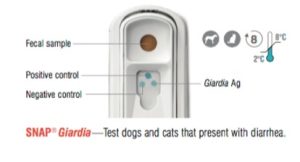Module 11: Rapid Point of Care (POC) Testing
Module 11.4: SNAP® Giardia Test
SNAP® Giardia Test
Giardia is a protozoan parasite that causes small intestinal disease and diarrhea in a wide variety of animals, including people. In 2018, the state of Minnesota, 6.47% of dogs and 4.13% of cats tested were positive for this disease. Because of Giardia’s worldwide distribution and potential zoonotic potential, many diagnostic tests including point of care testing are available for the detection of Giardia. These tests are summarized in the following table.

The Giardia SNAP® Test we will be using in the laboratory is similar to the Canine parvovirus test in that it is also used to detect the free-floating antigen dispersed in the feces. This refers to an antigen that is not associated with a Giardia cyst wall or trophozoite.
Knowledge check
Patient selection for Giardia testing
The role of Giardia in the development of intestinal disease is still largely unknown in dogs as we can detect Giardia cysts and antigens in dogs and cats that are asymptomatic and having diarrhea. (See AOD1 notes for more specifics on the life cycle and pathogenesis)
A few hypotheses for asymptomatic animals and detection of the protozoan include:
- Does Giardia, similar to other diseases such as Coronavirus infections, develop a carrier state?
- Are these protozoans commensals? Are increases in shedding indicative of a state overall of microbial dysbiosis?
- This theory stems from the finding of commensal protozoans in other species including ruminants and humans that are beneficial to intestinal health
Since we can detect Giardia in both asymptomatic and symptomatic dogs, CAPC recommends that only symptomatic dogs be tested for Giardiasis using point of care testing including the Giardia SNAP Test. Additionally, for those dogs that are symptomatic and have completed the appropriate therapy, CAPC recommends the following, “Follow-up testing may be done 24-48 hours after the completion of therapy if clinical signs have not resolved. It is recommended to perform a fecal flotation with centrifugation primarily for the detection of cysts in solid or semisolid stools. ‘ELISA tests may remain positive even after treatment for variable periods of time and should not be used as a guide to determine reinfection or failure of treatment.” Thus a positive SNAP test should always be followed up with a fecal flotation to identify active disease in cases that may be refractive to treatment.
While we will not be discussing treatment specifically in this course, the following is a decision tree that may aid in answering the conundrum of “to treat or not to treat” in asymptomatic animals that Giardia is detected on fecal flotation.

Knowledge check
Giardia SNAP test procedure & interpretation
In the lab, you will be using the Giardia SNAP test to answer questions on your case. The following are guided instructions on how to perform the Giardia SNAP test followed by interpretation guidelines. You should notice that the interpretation guidelines are always in light of the fecal flotation findings.
- Bring test to room temperature if it has been refrigerated
- Obtain a sampling swab and a SNAP device for each sample to be tested. Pull and twist the tube covering the swab tip to remove the tube from the swab/reagent bulb assembly. Using the swab, coat the swab tip with fecal material. Then, return the swab to the tube. NOTE: Only a thin coat of fecal material on the swab is required; do not coat the swab with excess feces.
- Break the purple valve stem inside the bulb assembly by bending the assembly at the narrow neck, re-bending the opposite way may be helpful. Squeeze the reagent bulb three times to pass the blue solution through the swab tip and mix it with the sample.
- Place the SNAP device on a horizontal surface. Using the swab as a pipette, dispense 5 drops of the fluid into the sample well, being careful not to splash contents outside of the sample well. The sample will flow across the result window, reaching the activation circle in 30–60 seconds. Some samples may remain in the sample well.
- When color FIRST appears in the activation circle, push the activator firmly until it is flush with the device body
- Some samples may not flow to the activation circle within 60 seconds, and, therefore, the circle may not turn color. In this case, press the activator after the sample has flowed across the result window.
- Read the test result at 8 minutes.

Interpretation of Giardiasis testing
The following information below was taken directly from the Cornell University Animal Health Diagnostic Center Website.
Giardia ELISA Positive/Flotation Positive
The animal is infected with Giardia.
Giardia ELISA Positive/Flotation Negative
The animal may be infected with Giardia but is shedding cysts below the limits of detection by flotation. Alternatively, the ELISA is a false positive that may be seen most frequently when the results are in the low positive range. To resolve the issue, collect a second sample for analysis.
Giardia ELISA Negative/Flotation Positive
The animal may be infected with Giardia but is producing antigen below the limits of detection by ELISA. Alternatively, the ELISA is a false negative. To resolve the issue, collect a second sample for analysis.
Giardia ELISA Negative/Flotation Negative
To answer the questions in your laboratory activity. Please refer to the IDEXX website.

